My shopping cart
Your cart is currently empty.
Continue Shopping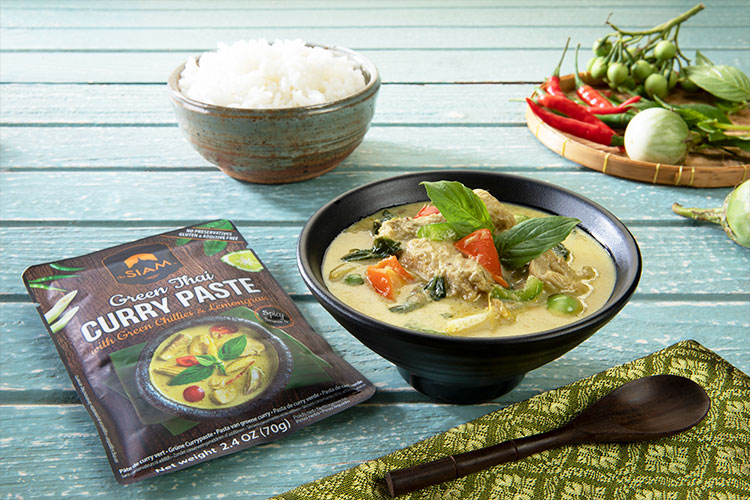
If you look at restaurant menus around the world, it would be easy to think that Thai curries come in just three colors. End of story.
But in Thailand, nothing could be further from the truth.
Thai curry pastes have unique flavor profiles that are suited to a multitude of dishes and cooking techniques.
Called prik gaeng in Thai, curry pastes are the base of countless traditional and modern recipes.
There are basic ingredients that almost all of them have in common.
When making pastes, Thai cooks prefer the aroma of tiny cloves of Thai garlic with skins so thin that they don’t need to be peeled. They also favor Thai shallots that are smaller and more fragrant than their western cousins.
Some pastes incorporate aromatics that are distinctly Thai in flavor: lemongrass, galangal, makrut lime leaves and coriander roots are used not just in curries but in many Thai dishes from soups to stir fries.
They add fresh, bright, floral notes that are the immediately recognizable signature of Thai food. And of course what would a curry paste be without chili peppers?
Red or green, fresh or dried, mild or ferocious, they are what give pastes their assertive personalities. Though closely associated with Thai and other Asian cuisines, chili peppers are of a New World import that arrived in Asia "only" about six centuries ago on the ships of Portuguese traders who were looking for gold, gems, indigo, spices and other valuable commodities.
Before that, heat came from peppercorns, which are still common in curry pastes today. Yellow curry gets its glow from nubs of turmeric. Panang and massaman rely on warm dry spices like cardamom, cinnamon, coriander seeds, cumin and cloves that originally arrived with Persian and Indian merchants.
Green curry logically uses green chillies, whereas most other pastes use red ones. All these ingredients are traditionally pounded in stone mortars, a time-consuming, labor-intensive process. Curry pastes are also at the heart of other dishes that don’t fall into the category of what we’d usually think of as a curry. They can spice up stir-fries, give fried rice a kick or even garnish surprising pizzas. Here are just a few dishes that you’ll find on the street, and that you can recreate at home.
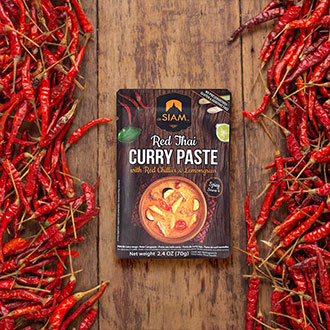
Red curry is called gaeng phet, or "spicy curry" in Thai. While most people will be familiar with the curries thickened with coconut milk, not all red curry dishes swim in sauce. Pad prik king made with red curry paste is one of the most popular stir fries in Thailand. It can be made with a variety of ingredients including crispy pork, prawns or salted egg.
Common vegetable additions include long beans or morning glory. In upscale restaurants, you can even find luxury versions that feature lobster. The name of the dish, which literally translates as chili ginger stir fry, is misleading. While pad prik king does contain red chillies, it isn’t a particularly spicy dish. Even odder, it contains no ginger at all. Instead it derives its fragrance from undiluted curry paste, with a faint hint of sweetness from coconut or palm sugar.
No one knows for sure how pad prik king got its name, but some experts speculate that it comes from the dish’s gentle heat, akin to the mild spiciness of ginger. Pad prik king isn’t a dish with a lot of sauce. Instead the curry paste clings to the main ingredients, ensuring every bite packs a wallop of flavor. Tip: Red curry paste is used in other dishes, too. Thai cooks add a spoonful to fish or shrimp cakes for extra zing.

Green curry fried rice is the perfect marriage of two quintessentially Thai dishes. The iconic green variety, known as "sweet green curry" in Thai, is one of the most popular. Despite the sweetness in its name, green curry can pack a punch. The dish is particularly popular in Bangkok and the center of the country, often served over rice noodles.
Fried rice is one of the ultimate comfort foods common all around Asia and is hands down the best way to use up leftover rice. When green curry meets fried rice, magic happens. The joy of fried rice is that you can add any meats or vegetables you have.
This recipe uses tofu, but consider all sorts of other ingredients from cooked meat – fried rice is a great vehicle for leftovers –, prawns, or mixed vegetables. Tip: For an authentic shophouse feel, add a lacy fried egg perched on top. To get crispy edges on the egg, there should be enough piping hot oil at the base of the pan for the egg to float.
Bonus tip: For a change of pace from rice, Thais also love green curry stir-fried with spaghetti. Add al dente spaghetti to a green curry, and finish cooking until the sauce is almost completely absorbed. This popular fusion dish is available in fashionable cafés and modest food courts all over Thailand.
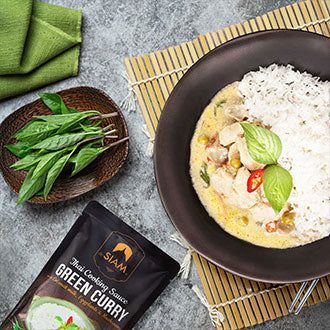
The famous Green Curry originated in the Central Thailand and is called “Gaeng Khiao Wan’ in Thai. Despite its soft, sweet color, Green Curry tends to be more pungent and is the spiciest curry of all.
The Green Curry Paste is made from fresh green chillies which gives the color and name to the curry. Mixed with shallots, garlic, galangal, lemongrass, kaffir lime leaves, coriander roots, cumin seeds, white peppercorns, shrimp paste and salt. When cooking the Green Curry, besides the chilli paste, the other main ingredients include coconut milk, palm sugar, fish sauce, Thai eggplant (aubergine), pea aubergine, basil leaves and meat – traditionally fish, fish balls, chicken, pork, beef or tofu.
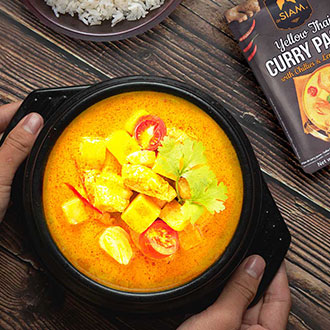
Yellow curry is considered the mildest of curries and because of that it is also one of the most popular. It’s commonly made with chicken or crab, but it is also a favorite for plant-based dishes, like jackfruit.
With the growing popularity of vegetarian and vegan diets these days, jackfruit is all the rage. It has long been a go-to staple in Thailand, where it’s not uncommon to find a jackfruit tree in the backyard. The rough-skinned fruit is the shape of a bloated watermelon that regularly reaches 10 kilos, though it is not unheard of for a single fruit to grow to 20 kilos or more. It’s also readily available for sale most of the year. If you’re lucky enough to find it fresh, either in the garden or at the market, you want green, unripe jackfruit for your curry. Ripe fruit in which the pods have turned yellow and the seeds have formed is best for snacking and dessert.
Outside of Southeast Asia, both canned and frozen jackfruit are widely available and work perfectly well in curries and soups, like yellow curry. The flesh is neutral so it naturally soaks up the flavor of the curry while the texture of the fruit has a satisfying chew to it. Substitute 250 g of jackfruit for the prawns and salt to taste for fish sauce in this recipe for a completely vegan dish. Another popular dish from Eastern Thailand is yellow curry with durian. To say that the fruit is polarizing is an understatement. Die-hard fans are addicted to the pungency of the fresh fruit; detractors compare its aroma to wet socks.
When cooked, durian, called the King of Fruits, takes on a mellow creaminess. Adventurous eaters will be rewarded with an amazing, one-of-a-kind culinary experience. Tip: If using fresh or frozen jackfruit, remove the peel, cut into cubes and steam until fork tender, about 20 minutes. If using tinned jackfruit, rinse in water to remove the brine, boil in salted water for ten minutes or until fork tender, then drain.

Panang curry is a recipe that was embraced by cooks in the royal palace during the 19th century in what was still the new capital of Siam, the city the world knows as Bangkok but that locals call Krung Thep.
How panang got to the court is subject to debate. It could be a southern dish, its name a corruption of Penang Island that in the 19th century was part of Siam and is now in Malaysia. It might be an invention of the Central Plains, where Bangkok is located.
Others say it comes from the north or the west. What we do know is that by 1890 when Mom (the title for a lady who has married a prince) Somchin Rachanupraphan published a book called Thamra Kap Khao (loosely: Cookbook for Dishes with Rice), it was already hugely popular. Tip: For the distinctive richness of a panang curry, you can add a few spoonfuls of roasted crushed peanuts or cashews (or a little peanut or cashew butter) to the simmering sauce.
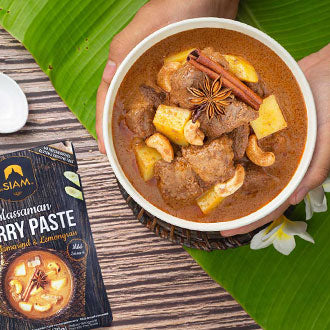
Massaman, a Muslim dish almost certainly brought by Persian traders, has a long history in Thailand. The merchants brought exotic spices to the court of Ayutthaya, the former capital, over five centuries ago.
Whether it was the palace chefs or the merchants who first made massaman, we’ll never know, but the heady blend of imported and local aromatics and the addition of rich coconut milk has been known and loved for centuries.
Some of the earliest written recipes derive their sweetness from pineapple or pineapple juice.
Beef is a classic in massaman curry recipes. You can also make chicken massaman using bone-in chicken legs or whole chicken chopped into pieces, but if you choose boneless thigh or breast, you can have dinner on the table in under half an hour.
Tip: There are other versions of massaman that use meats like duck or goat, but as massaman has Muslim origins, pork is never used for this dish in Thailand.